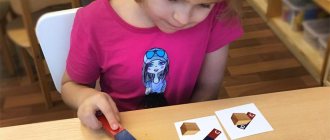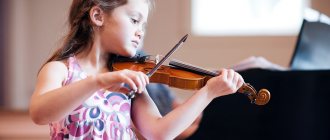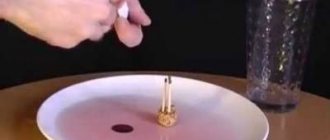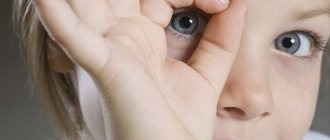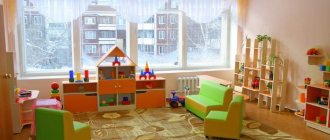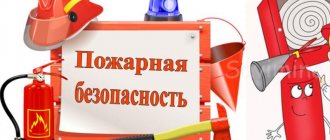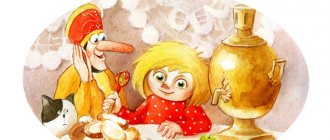Experiment No. 1: “Walking” water
To get started, you will need a set of the following materials:
Five transparent glasses of the same height (plastic cups will do);
Paper towels (napkins);
Water (tap);
Food coloring (three colors);
1. Have your child fill three cups with water and have them add coloring to each one;
2. Place an empty glass between two filled with colored water;
Ask your child if he knows what gravity is? If he doesn't already know this, explain that gravity is the force that attracts objects to each other. In this experiment, gravity will help the water move faster into an empty container.
3. Help your child fold the paper towel in half several times to create a long, thin strip about 2-3 cm wide. Repeat with the other paper towel (napkin) again;
4. Ask him to dip one end of a paper towel strip into a container of colored water and place the other end of the strip into an empty glass. Thus, the dry edges of two paper towels should fit into the dry cup.
All you have to do is wait - the water will begin to flow into the empty container within a few minutes; While you wait, make some predictions with your child: Will the water actually flow and how long will it take? What happens when you put two different colors together?
In a couple of hours you will see much more impressive results.
YouTube
Step-by-step instructions for the “Rainbow in a Glass” experiment for children
The teacher tells the group that during the trick you will get three rainbows at once. They will be different, but any of them can be repeated with parents at home.
For the first experiment, kids cut out strips 5 cm wide from a napkin and thick cardboard. At a distance of 3 cm from the edge of each of them, draw a transverse line with a simple pencil. Children put dots on them with felt-tip pens in 7 colors of the rainbow.
Strips of paper are lowered into the water so that it does not reach the points by 1 cm. After a few minutes, the colors on the napkin spread. This happens more slowly on thick paper.
The description of the “Rainbow in a Glass” experiment for children in the second version will require turning off the lamps in the group. The teacher lowers the mirror halfway into a glass or other container with water. Children point a flashlight at it and see where the rainbow appears. You can try to catch it on a piece of paper.
Step-by-step instructions for the third experiment “Rainbow in a glass” are more complex:
- Arrange the cups in a row according to the number of dyes. Leave the first empty, put one spoon of sugar or salt in the second, 2 in the third, 3 in the fourth, and so on.
- Add 45 ml of warm water to all glasses and dissolve the contents in it. The main thing is not to confuse the order.
- Add food coloring or gouache and mix. Add a couple of drops of red to the container with the largest amount of sugar, orange, yellow to the next, and so on.
- Using a syringe, carefully fill an empty glass with colorful liquids in order. Different densities will prevent them from mixing.
To share the children’s successes with parents, you can film the “Rainbow in a Glass” experiment conducted in kindergarten or take vivid photographs of the participants with the results of the experiments.
Experiment No. 2: Visually about the density of matter
An even simpler experiment in which you will need:
Transparent container (glass or jar);
Food coloring;
Liquids of different densities - for example, honey, vegetable oil, liquid soap, glycerin, water, alcohol, milk, and so on;
And also small objects: some kind of steel bolt, a piece of glass, rubber and, for example, paraffin.
1. We tint colorless liquids using dye;
2. We take a glass and carefully pour denser liquids into it first - for example, honey, milk, liquid soap, water, vegetable oil, motor oil, alcohol, and so on. Try to do this with your child so that he has an interest in participating in the process;
3. Carefully, without shaking or mixing the liquid, lower various objects into the container. Since their density is also different, they will be distributed on the surfaces of different liquids.
Ta-dam! This experiment will clearly show what the density of matter is.
YouTube
IMPORTANT! If you pour substances not intended for human consumption into the container, we throw it away after the experiment so that no one accidentally drinks from it afterwards.
see also
Production of liquefied argon, interaction of cesium with water and other fascinating video experiments
Rainbow in a glass and other experiments with immiscible liquids
Have you ever heard that water and oil do not mix? Today we will first check if this statement is true, and then experiment with several other liquids
Have you ever heard that water and oil do not mix? Today we will first check if this statement is true, and then experiment with several other liquids. Liquids have properties such as miscibility with other liquids, viscosity and density. Today we will talk about these qualities of substances. And we’ll not only talk, but also look at how they manifest themselves... in the most ordinary glass.
Water and oil
You will need: 60 milliliters of water;
60 milliliters of vegetable oil; a small transparent glass; food colorings. First, pour water into the glass. Add some food coloring and stir. Then slowly pour the oil into the same glass. What do you see? Which layer is on top? Cover the glass tightly with a plastic lid or your hand and shake the glass until both liquids are mixed. Place the glass again and see what happens. Did water and oil mix? There is such a thing as “miscibility”. It characterizes the ability of two substances to mix. A pair of substances made of oil and water is called immiscible because they do not mix. The oil layer will be on top, and the water will be the bottom layer. The reason for this is the difference in density of the two liquids. The density of a substance is the ratio of its mass (weight) to its volume. The density of oil is lower than that of water, so the oil will end up at the top.
Liquid multilayer “traffic light”
You will need: 60 milliliters of artificial or natural honey;
60 milliliters of dishwashing liquid; 60 milliliters of water; 60 milliliters of vegetable oil; 60 milliliters of denatured alcohol; tall transparent jar; two mixing glasses; food coloring. Take the jar. Pour honey into it; it should fill one sixth of the jar. Pour into the center of the neck so that the honey does not smear along the side of the jar. Once the honey is added, pour in the appropriate amount of liquid dish soap. Will the dishwashing liquid stay on top and honey on the bottom? Be careful to add subsequent liquids very slowly as they are less viscous than honey and dish soap and mix more easily than previously added liquids. And we don't need to mix them. So, first pour in the colored water, then the vegetable oil, and then the colored denatured alcohol. On a piece of paper, make a diagram showing the order in which the liquids were poured into the jar. Did each liquid remain in a separate layer? Note for yourself those properties that distinguish the liquids in the jar from each other. The first such property is color. The second distinctive quality of each liquid is its viscosity. The property that is responsible for the position of the layer in the jar is the density of the liquid. What is the relationship between the position of the liquid in the jar and its density?
Another quality is immiscibility. It is this that allows the liquid to remain a separate layer. As you saw during the first experiment, vegetable oil and water do not mix. On the other hand, water and denatured alcohol mix and form a single layer. Water and dishwashing detergent are also mixed. Stir the liquid in pairs in the glass and see what happens, whether layers form. Which liquids will mix with each other and which will not. After a few minutes, look at the effect again. Have the liquids formed separate layers?
Rainbow in a glass
You will need: four food colors of different colors (for example: red, yellow, green and blue); five tall transparent plastic glasses; 180 grams of granulated sugar; tablespoon (for measuring); 240 milliliters of water. Pour 15 grams (1 tablespoon) of sugar into the first glass. Add 2 tablespoons of sugar to the second glass. Three spoons - in the third glass and four - in the fourth. Add 45 milliliters (3 tablespoons) of water to each glass and stir until the sugar dissolves. If the sugar in any of the glasses has not dissolved, add an additional 15 milliliters (1 tablespoon) of water to each of the glasses. When the sugar is completely dissolved, add a little food coloring to each of the glasses. For each of the glasses, use a different color of dye: red for the first, yellow for the second, green for the third and blue for the fourth.
In the fifth glass you can create a rainbow. Fill it a quarter full with blue sugar syrup. Then carefully add the green sugar syrup into the glass. Pour in the syrup carefully, spoon by spoon. Then add yellow sugar syrup, followed by red sugar syrup. Add carefully, spoon by spoon, avoiding mixing layers. What words would you use to describe the colorful substance in the glass? The amount of sugar dissolved in a liquid determines its density. The blue solution is the most saturated with sugar and, as a result, the densest. The remaining solutions are less dense than blue, therefore they will be located on top of it. The thickest syrup will be at the bottom. In this case, the solutions, despite the difference in density, can be mixed. Therefore, there will be no clear boundaries between liquids, which we could observe in the first experiment. But if you do everything carefully enough, the liquids will be located in relatively separate layers. What do you think will happen if you mix all the liquids in a glass together? Caution must be taken during scientific experiments. The ingredients are not food grade. The dishes should be washed thoroughly after completing a series of experiments.
Experiment No. 3: “Slowing the Fall”
No less simple, but such a cool, almost “magical” experiment!
For it we will need:
Copper thick-walled tube with a hole diameter of 2-3 cm;
A neodymium magnet, whose outer diameter should be a couple of millimeters smaller than the inner diameter of the tube.
Attention! Despite the only two elements required for the experiment, getting them will not be so easy, but you will definitely like the result, and your child will simply be delighted with it!
1. To begin with, we demonstratively drop the magnet without the tube. It will fall, like any other object, to the floor in a split second;
2. Now we take our metal blank and throw a magnet into it, like this:
YouTube
A beauty, isn't it? We are sure that your child will instantly want to play with a new toy, regardless of age, 4, 5, 10 years or more. Give him this opportunity.
Explaining from a textbook that a falling magnet changes the magnetic flux in the pipe in such a way that it induces (induces) an electric current, the direction of which is determined by Lenz's rule, which in turn generates a magnetic field, will most likely be too early (and even then if you are in you figure this out yourself), but you will most likely be able to amaze a child and, perhaps, give him a desire to engage in interesting, entertaining science.
Abstract of OOD "RADUGA - DUGA"
Summary of a lesson on cognitive and research activities for preschoolers “RAINBOW - ARC”
Educator: Sesoreva M.A.
Target:
Development of children's research abilities, consolidation of knowledge about the colors of the rainbow.
Objectives:
• Improve the ability to observe and analyze objects of the surrounding world;
• Develop a desire to participate in creative activities; • To cultivate a positive emotional and value-based attitude towards the world around us, Plan:
1. Conversation “Fairytale Rainbow” 2. Learning the acrostic phrase “Every Hunter...” 3. Experience-experiment “Rainbow on a disk” 4. Drawing “Flower - seven-colored” 5 .Reading: “The Legend of a Boy Named Rainbow”
Lesson progress: MORNING 1. CONVERSATION “A FANTASTIC RAINBOW”
The rainbow is one of the most fabulous phenomena of nature. Rainbow is
companion of the rain. A rainbow can appear before the rain, during the rain, and after the rain stops.
What is a rainbow? A rainbow is an arc of color. It can be seen against the background of the rain. A rainbow is observed in the side of the sky that is opposite to the sun, while the sun is not covered by clouds. Most often, such conditions are created in the summer, during the so-called “mushroom” rains. There are seven colors in the rainbow. - Where else besides the sky can you see a rainbow? (children's answers)
— A rainbow can be seen near a fountain or waterfall, against the background of drops from a sprinkler.
A rainbow can be seen at a time when the Sun is shining in parallel with the rain. To see it, you need to be strictly between the Sun and the rain. In this case, the Sun should be behind, and the rain should be in front. —Where does the amazing colorful light emanating from a rainbow come from? The source of the rainbow is sunlight. This light moves across the sky in such a way that it appears to come from that part of the sky that is opposite to the Sun. 2. LEARNING THE ACROSTIC PHRASE “EVERY HUNTER...”
Everyone is Red;
Hunter - Orange; Wishes - Yellow; Know - Green; Where - Blue; Sitting - Blue; Pheasant - Purple. 3. EXPERIMENT “RAINBOW IN A GLASS” (using a CD)
- Take the CD and wipe it so that it is not dusty.
- Place it on a flat surface, under a light or in front of a window. - Look at the disk and enjoy the rainbow. You can spin the dial to see how the colors move. 4. DRAWING “FLOWER – SEMIFLOWER
5.READING:
"The LEGEND OF A BOY NAMED RAINBOW"
This happened in the old, old days. At that time there was only one large island on Earth in the middle of the ocean. And colorful people lived on this island. They did not have a school, so they were all ill-mannered, greedy and evil. Multi-colored people constantly argued with each other, were mischievous, and called names. One day a boy with silver skin and golden hair appeared on this island. His name was Rainbow. He was the son of the Sun and Cloud. Rainbow always looked down on people and really wanted to get to know them. He didn't know what they really were. Multi-colored people seemed very beautiful, cheerful and friendly to him. The boy spent a long time trying to persuade his parents to let him go to Earth. And finally, he received permission and found himself on the island among people. He happily walked down the street and said hello to everyone he met. But in response, people were rude to him, teased him and laughed evilly. The rainbow came to a large area. There were a lot of colorful people here. And all of them, as always, shouted and called names, some even fought. The boy was very upset. Now people seemed scary, crooked and evil to him. Rainbow wanted to run away, to return home to her parents. But he was a very kind boy and decided to reconcile all the colorful people. “They need to see themselves from the outside, how scary and ugly they are,” thought Rainbow. “But how to do this?” In those days there was no mirror on Earth. Then the boy came up with the idea: “We need to draw them!” But Rainbow did not yet know how to draw large pictures, and the only artist on the island did not agree to teach him. But Rainbow did not give up. Every day he began to go to the garden, where the only artist painted his paintings. The boy hid in the bushes and carefully watched the work of the only artist. Then Rainbow took the brushes and paints that he begged from his Aunt Nature and tried to paint. That's how I learned. Time passed. And then one day Rainbow woke up and realized that he was ready to paint his picture. He worked for a long time. I walked the streets, observed and drew, observed and drew. And now, the picture is ready! Rainbow installed it in the largest area and covered it with a black blanket until the morning. And he went to bed. But the colorful people did not sleep that night. They have long wanted to somehow harm this good-natured Rainbow. And so, when the picture appeared on the square, they came up with a cruel joke. Multi-colored people made their way into the square, pulled the black cover off the painting and poured black paint on it. They were so busy with their villainy that they did not even look at what was painted in the picture. In the morning Rainbow ran to the square and wanted to remove the black cover from the painting. But it was not filmed. The boy was surprised, but then he realized what had happened and began to cry. And colorful people stood around and laughed. Then they started spraying him with colorful paints. Everything was dirty. Rainbow could not stand this and asked his parents to take him home. At home, Rainbow washed off all the paint, but he couldn’t wash his hair. So they remained colorful. Then the boy told his parents everything and asked his mother Tuchka to wash off the black paint from the picture, and his father Sun to illuminate the picture brightly. Let colorful people look at themselves from the outside. Mom Cloud and dad Sun fulfilled their son’s request. The colorful people were still in the square. They screamed and argued, fought and bit. And they didn’t even notice how Tuchka’s mother came and washed off the black paint from the painting with the rain. But then Father Sun appeared and illuminated his son’s picture brightly. The noise slowly began to subside. And suddenly all the colorful people turned red. Everyone saw themselves in the picture. And they all felt very, very ashamed. Everyone stood and was silent. Then Father Sun decided that colorful people were too different from each other. It will be better if they become one color. It began to shine brighter and brighter, burning people and tanning them. But some people stood in the very sun and became dark brown, others were in the shade and their skin became white, and others became yellowish. This is how three races appeared on Earth: blacks, Europeans and Mongols. But the Sun not only repainted people, but also made their hearts warm and kind. Since then, all people on Earth have become friends. Then the only large island was divided into several islands, but the friendship between such different people does not stop. And every time when mother Cloud washes the Earth, and father Sun illuminates it, the boy Rainbow looks at people, so different, but friendly and happy, and rejoices. And with joy, his hair begins to shimmer with multi-colored colors, and a rainbow appears in the sky.
Experiment No. 4: “Newton’s Cradle with your own hands”
For the experiment you will need:
Three bottles of the same volume filled with water (half a liter will be enough);
Ball, ball (not very big, but massive enough that it could knock down one bottle like a pin).
The experiment has begun!
1. We place the skittle bottles one after another;
2. We launch the ball into the bottle. Having done this, you will see that the last bottle in the row will fall.
Before you let your child have fun with physics, briefly explain to him that this is called Newton’s cradle (pendulum) effect, which demonstrates to us the transformation of energy of different types into each other: kinetic into potential and vice versa.
adme.ru
see also
Two methods for making homemade invisible ink: one tested (works)
Experiment No. 5: Making a transparent egg shell
From physical experiments to chemical experiments.
You will need:
A raw egg;
Table vinegar.
The experiment is quite long (from a day to two), but the end result, we are sure, is worth it!
1. Pour vinegar into a container. It is advisable to use 9 percent vinegar;
2. We immerse the whole egg in the liquid so that the shell is completely hidden under its level;
3. We wait a day or two.
The point of the experiment is that vinegar will eat away the calcium that makes up the shell, leaving only the inner film between the protein and the shell. In this case, the protein itself will thicken from interaction with vinegar.
It is interesting that calcium carbonate, of which the shell is mainly composed, will begin to release carbon dioxide as it disintegrates. You can also tell your child about this. It's interesting and educational!
Attention! Eggs should not be eaten! You've seen what vinegar does to protein...
[media=
https://youtu.be/7VhsyMU_8UU
]
YouTube
Here are more advanced experiments with chicken eggs:
YouTube
Rainbow experimentally
In order to make sure that there really are seven colors in the rainbow, and to investigate this natural phenomenon, we conducted a series of experiments. (Appendix 3)
Experiment 1. Artificial rainbow
Required material:
A container of water, a sheet of white paper, a flashlight, a mirror.
Progress of the experiment:
Pour water into the container and lower the mirror to the bottom. We direct the light of the flashlight onto the mirror. The reflected beam of light must be “caught” on the paper. Due to the refraction of the ray, a rainbow appears on the sheet.
Explanation:
A ray of light consists of several colors; when it passes through water, it is decomposed into its component parts - the seven colors of the rainbow.
Experiment 2. Rainbow soap bubbles
Required material:
Container with soapy water, device for blowing bubbles.
Progress of the experiment:
We take the device, dip it in a container of soapy foam and blow out the bubbles.
You can see a seven-color rainbow on the bubbles flying in the air.
Explanation:
Rays of light hitting the bubble are refracted and produce beautiful rainbow colored rings, which Isaac Newton was the first to study.
Experiment 3. Decomposition of white light into a spectrum using a CD
Required material:
CD, white paper, flashlight.
Progress of the experiment:
Let's take a disk. Let's point a flashlight at it so that rays of light fall on its mirror surface. We direct the light using a disk onto a white sheet of paper. We change the tilt of the CD, and then we can see many “rainbow” patterns.
Explanation:
Light is refracted on the mirror surface of the disk, similar to the refraction of sunlight in a drop of water. That's why we can see a rainbow.
Experiment 4. How to get white from a Rainbow
Required material:
A paper circle painted in seven colors of the rainbow; match - axle.
Progress of the experiment:
We make an axis from a match in the center of the paper circle. We begin to rotate quickly. Instead of a colored circle, we will see a white one.
Explanation:
The human eye cannot see each color separately on a rapidly rotating circle, and for it all colors merge into one white color.
Experience 5. Rainbow on the phone
Required material:
Telephone, table lamp, CD.
Progress of the experiment:
We shine a lamp on the mirror surface of the disk. Turn on the camera on your phone and point it at the disk. A rainbow appears over the entire surface of the disk.
Explanation:
The phone's camera, like our eye, perceives light. The disk splits the white light of a flashlight into seven colors of the spectrum. Therefore, we can observe a rainbow on the mirror surface of the disk through the phone camera.
Conclusion
At the beginning of our work, we made the assumption that a rainbow in nature appears only after rain and has seven colors.
While studying the literature, we found out that raindrops can divide white into seven colors of the spectrum, but only when the sun is shining.
In the course of practical experiments, we found that there are several ways to experimentally form a rainbow, and that a rainbow actually has seven colors: red, orange, yellow, green, blue, indigo and violet.
Therefore, the following conclusions can be drawn:
- Rainbows are a natural phenomenon, the study of which requires a lot of effort and is very interesting.
- The main condition for the appearance of a rainbow in nature is the presence of sunlight and rain.
- Obtaining a rainbow experimentally allows for a more detailed study of this rainbow.
The practical part of this work is that by acquiring information about a previously unstudied topic, you can not only enrich your own knowledge, learn to obtain knowledge from additional sources, analyze the material received, but also share your results with peers who, in our opinion, benefit from this topic will be interesting.
Thanks to such work, activity in the cognitive sphere of activity increases, which is the main factor for the development of the student’s personality.
Bibliography
- Dal V.I. Explanatory dictionary of the Russian language. Modern version. - M.: ZAO Publishing House EKSMO - Press, 2000. - 736 p.
- Zubkova N.M. A cart and a small cart of miracles. Experiments and experiments for children. – St. Petersburg: Rech, 2006.-64 p.
- Levkievskaya E. E. Myths of the peoples of the world. - M.: Astrel, 2000. - P. 90. - 528 p.
- New encyclopedic dictionary / Under the general. ed. acad. K.K. Arsenyeva. - St. Petersburg: Publishing house F. A. Brockhaus and I. A. Efron, 1911-1916. - T. 26.
- Newton I. Optics or treatise on reflections, refractions, bendings and colors of light / Translation by S. I. Vavilov - 2nd ed. - M.: State. Publishing house of technical and theoretical literature, 1954. - P. 131. - 367 p.
- Ozhegov S.I., Shvedova N.Yu. Explanatory dictionary of the Russian language: 80,000 words and phraseological expressions / Russian Academy of Sciences. Institute of Russian Language named after. V. V. Vinogradova. — 4th ed., supplemented. - M.: Azbukovnik, 1999. - 944 p.
- Yakovleva M.A. Fun science experiments for kids and adults. Experiments in the room. – M.: Eksmo, 2012. – 64 p.
Appendix 1. Newton's Color Spectrum
Experiment No. 6: Creating a Rainbow Arc
Experiment kit:
Tray:
Mirror;
Water;
Flashlight;
A piece of white paper.
1. Fill the tray halfway with water;
2. We immerse the mirror in it as shown in the photo below, but you can do it completely:
center-sozvezdie.ru
3. Place a sheet of white paper on the opposite side;
4. We direct the turned on flashlight at the mirror so that the reflected light hits the paper. And here it is - RAINBOW!
YouTube
This is how dispersion occurs - the decomposition of white light into a spectrum (rainbow). After such a visual and colorful experience, a 5th or 6th grade student, if you explain to him what dispersion is, will most likely even remember this concept even before starting the physics course.
see also
20 photos showing the beauty of the world found in simple things
Progress of the experiment:
I used: a rectangular tray, plain water, a mirror, a table lamp. I poured some water into the tray and lowered the mirror into it at a slight angle. The beam of light from the lamp was directed onto the part of the mirror immersed in water.
By adjusting the tilt of the mirror, I got this rainbow .
Conclusion: As a result, a reflection of all the colors of the rainbow , we were able to get a rainbow at home
conditions.
(Appendix No. 1)
Experiment No. 2 Growing rainbow
Material: plastic cup, napkin, water, markers
Experiment No. 8: “Non-Newtonian fluid” at home
For the experiment you will need:
container (for example, tray);
starch;
water;
dye.
1. Pour the starch into a container;
2. Mix with water in a ratio of 2 to 1 (according to other sources, the proportion should be 1 to 1). That is, there should be half as much water as starch (as shown in the video below);
3. Mix thoroughly to obtain a homogeneous thick mixture. If necessary, add more starch for thickness;
4. Add dyes (optional, this will not affect the quality of the non-Newtonian liquid)
YouTube
Normally, in a container, the liquid will look like water and behave as such, but if you apply force to it, for example, sharply squeezing your palm while immersed in it, you will feel solid pieces. Between the fingers. Or, as in the experiment above, upon impact the liquid becomes very viscous, almost solid.
YouTube
Attention! Do not let your child beat the non-Newtonian liquid with his hand, only with some object, such as a pestle, to avoid injury.
see also
How to learn to juggle, and where to start?

